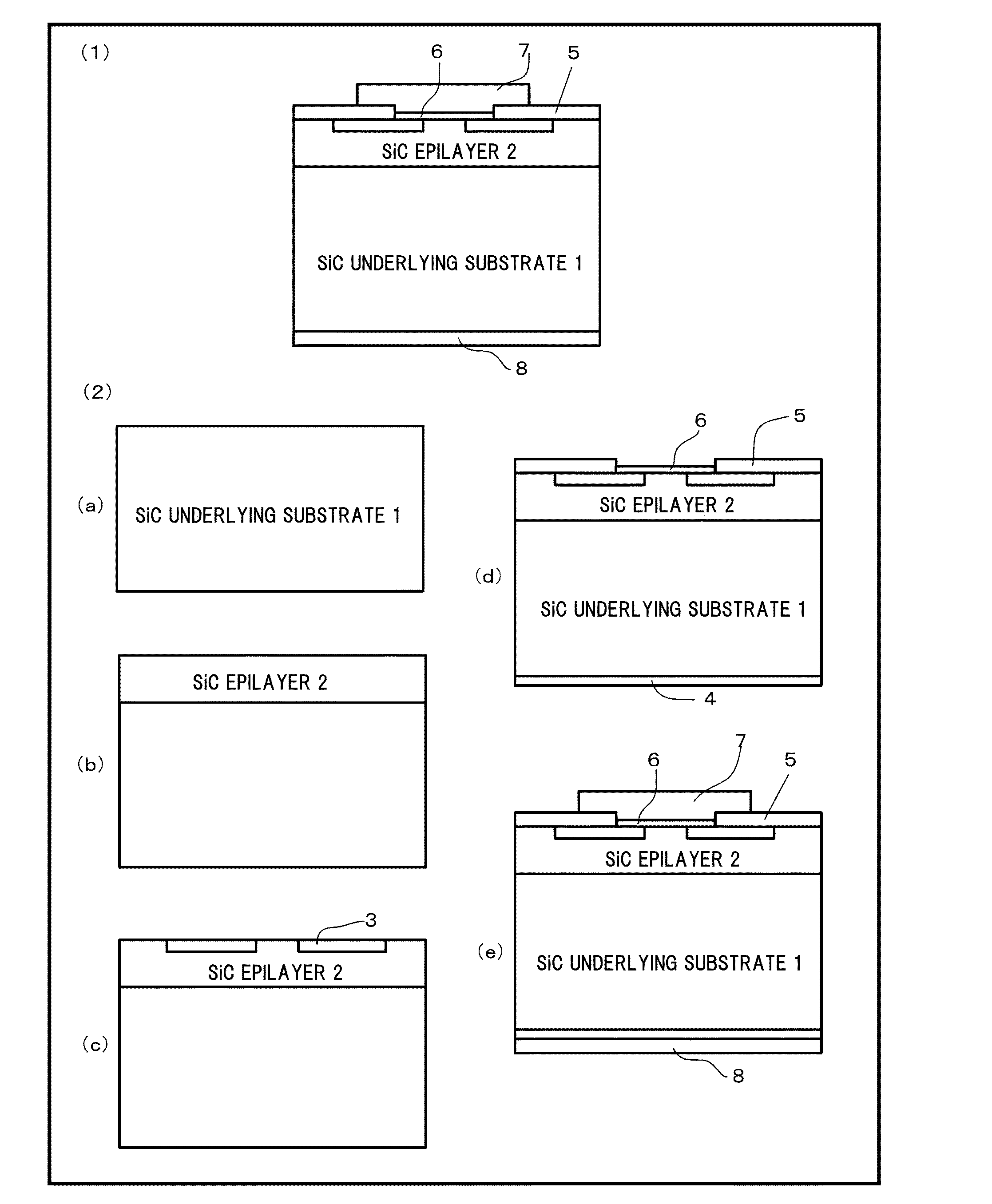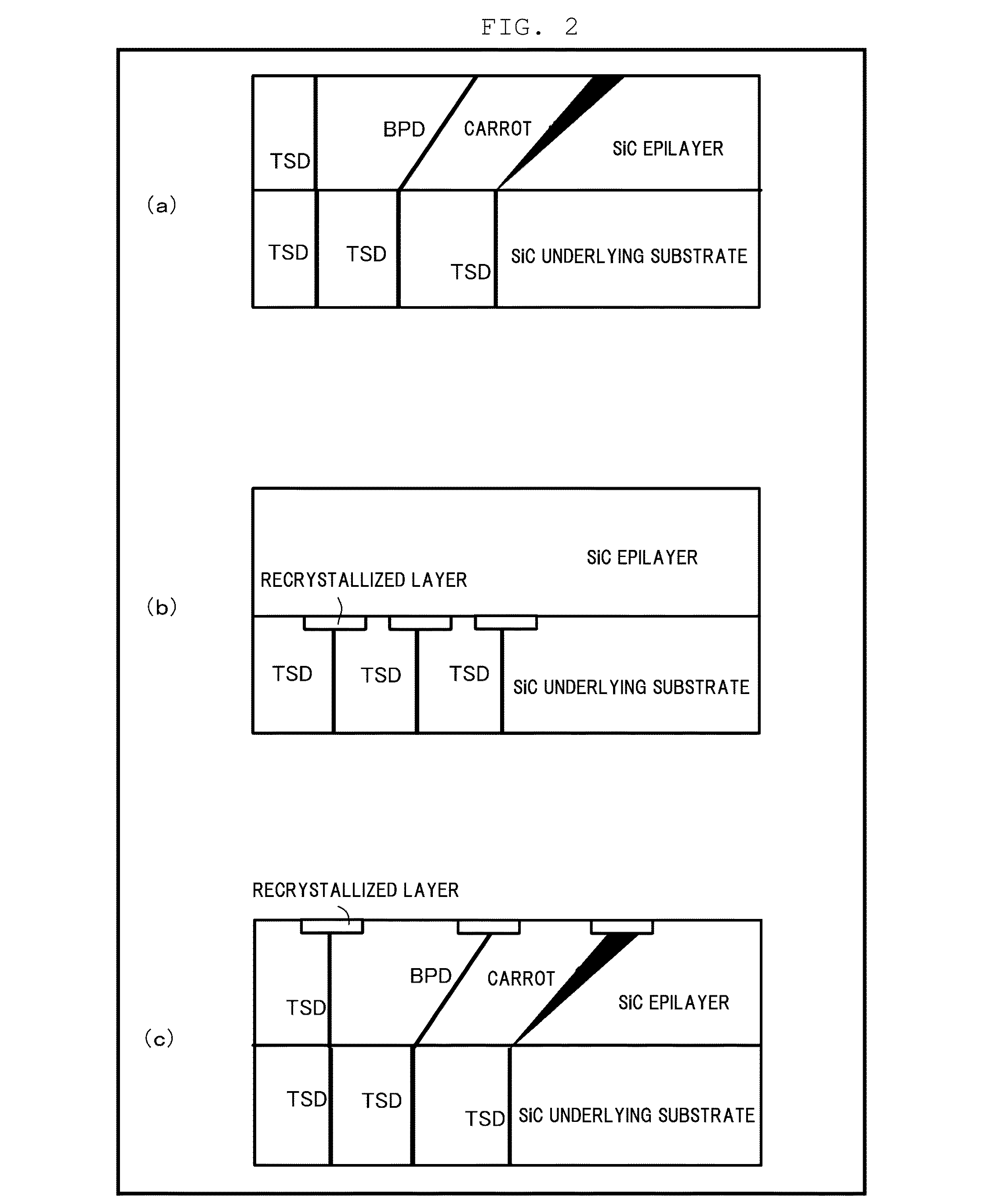Silicon carbide semiconductor device and manufacturing method for same
a technology of silicon carbide and semiconductor devices, which is applied in the direction of semiconductor devices, basic electric elements, electrical equipment, etc., can solve the problems of increasing the likelihood of crystal growth irregularities, crystal mixtures of different polytypes are unavoidable, and crystal defects such as dislocations are likely to occur, so as to achieve outstanding electrical characteristics and eliminate surface defects
- Summary
- Abstract
- Description
- Claims
- Application Information
AI Technical Summary
Benefits of technology
Problems solved by technology
Method used
Image
Examples
example 1
[0071]SiC-SBD was fabricated in accordance with the manufacturing process shown in FIG. 1.
[0072]As step (b), phosphorus was implanted over the entire Si surface of the SiC underlying substrate 1 in two stages to form an ion implantation region (strain layer). At this point, first stage implantation was performed at a dosage of 2×1015 cm−2 and an accelerating energy of 250 keV, and second stage implantation was performed at a dosage of 5×1014 cm−2 and an accelerating energy of 70 keV. Implantation was performed at room temperature. Next, as step (c), heat treatment using high-frequency induction heating was performed at a temperature of 1600° C. for 180 seconds under a normal pressure Ar environment, and the ion implantation region (strain layer) introduced in step (b) was recrystallized to form the recrystallized layer 13 (the heat treatment at 1600° C. for 180 seconds may be substituted with a heat treatment at 2000° C. for 30 seconds). Although not shown in the drawing, a carbon f...
example 2
[0076]An SiC-SBD was fabricated in accordance with the manufacturing processes shown in FIG. 4.
[0077]As step (b), an n−-type SiC epilayer 2 (1×1016 cm−3, 10 μm) was formed on the Si surface of the SiC underlying substrate 1 (a buffer layer (1×1018 cm−3, 0.5 μm) may be formed here prior to forming the n−-type SiC epilayer 2). An inspection was performed using a surface defect evaluation apparatus subsequent to forming the n-SiC epilayer 2, and four defects / cm2 were detected.
[0078]Next, ion implantation of Al was performed in three stages using an oxide film mask (not shown) formed on the surface of the SiC epilayer 2 by photoetching to form a voltage withstanding structure part. The p-type regions 3 were formed by performing ion implantation in sequence having as implantation conditions 5×1012 cm−2 / 350 keV in the first stage, 3×1012 cm−2 / 150 keV in the second stage, and 2×1012 cm−2 / 100 keV in the third stage. The implantation temperature was 500° C. Next, as step (d), after forming a...
PUM
| Property | Measurement | Unit |
|---|---|---|
| temperature | aaaaa | aaaaa |
| thickness | aaaaa | aaaaa |
| resistivity | aaaaa | aaaaa |
Abstract
Description
Claims
Application Information
 Login to View More
Login to View More - R&D
- Intellectual Property
- Life Sciences
- Materials
- Tech Scout
- Unparalleled Data Quality
- Higher Quality Content
- 60% Fewer Hallucinations
Browse by: Latest US Patents, China's latest patents, Technical Efficacy Thesaurus, Application Domain, Technology Topic, Popular Technical Reports.
© 2025 PatSnap. All rights reserved.Legal|Privacy policy|Modern Slavery Act Transparency Statement|Sitemap|About US| Contact US: help@patsnap.com



